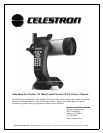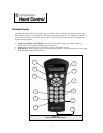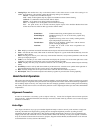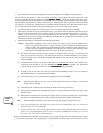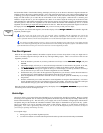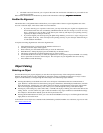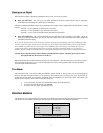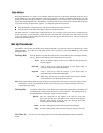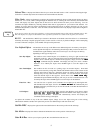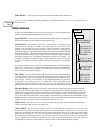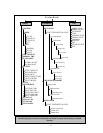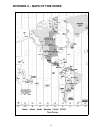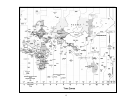
5
the Star Pointer finder. Once finished slewing, the display will ask you to use the arrow buttons to align the selected star
with the red dot in the center of the Star Pointer. If for some reason the chosen star is not visible (perhaps behind a tree
or building) you can press UNDO to select and slew to a different star. Once centered in the finder, press ENTER. The
display will then instruct you to center the star in the field of view of the eyepiece. When the star is centered, press
ALIGN to accept this star as your first alignment star. (There is no need to adjust the slewing rate of the motors after
each alignment step. The NexStar automatically selects the best slewing rate for aligning objects in both the Star Pointer
and the eyepiece). After the first alignment star has been entered the NexStar will automatically slew to a second
alignment star and have you repeat the same procedure for that star. When the telescope has been aligned to both stars
the display will read Alignment Successful
Alignment SuccessfulAlignment Successful
Alignment Successful, and you are now ready to find your first object.
If the wrong star was centered and aligned to, the NexStar display will read Align Fa
Align FaAlign Fa
Align Failed
ilediled
iled. Press UNDO to begin the
alignment procedure again.
If you are not sure if the correct star was centered, always remember that the alignment star will be the
brightest star nearest the field of view of the finder. There may be other fainter stars visible that are closer to the
center of the Star Pointer, but the actual alignment star will be obviously brighter than any other star in the area.
For the best possible pointing accuracy, always center the alignment stars using the up arrow button and the
right arrow button. Approaching the star from this direction when looking through the eyepiece will eliminate much
of the backlash between the gears and assure the most accurate alignment possible.
T
T
w
w
o
o
S
S
t
t
a
a
r
r
A
A
l
l
i
i
g
g
n
n
m
m
e
e
n
n
t
t
With the two-star alignment method, the NexStar requires the user to know the positions of only two bright stars in
order to accurately align the telescope with the sky and begin finding objects. Here is an overview of the two-star
alignment procedure:
1. Once the NexStar is powered on, use the Up and Down scroll keys to select Two
TwoTwo
Two-
--
-Star Align
Star AlignStar Align
Star Align, and press
ENTER.
2. The NexStar display will ask you to move the telescope tube until it is horizontal to the ground. To do this,
use the direction keys (3) to move the telescope until it is roughly level with the ground. Press ENTER.
3. Th e SELECT STAR 1
SELECT STAR 1SELECT STAR 1
SELECT STAR 1 message will appear in the top row of the display. Use the Up and Down scroll keys
(10) to select the star you wish to use for the first alignment star. Press ENTER.
4. NexStar then asks you to center in the eyepiece the alignment star you selected. Use the direction buttons to
slew the telescope to the alignment star and carefully center the star in the eyepiece.
5. Once the alignment star is centered in the field of view of the eyepiece, press the ALIGN key (2) to accept
this position.
6. NexStar will then ask you to select and center a second alignment star and press the ALIGN key. It is best to
choose alignment stars that are a good distance away from one another. Stars that are at least 40º to 60º apart
from each other will give you a more accurate alignment than stars that are close to each other.
Once the second star alignment is completed properly, the display will read Alignment Successful
Alignment SuccessfulAlignment Successful
Alignment Successful, and you will hear
the tracking motors turn-on and begin to track.
Q
Q
u
u
i
i
c
c
k
k
-
-
A
A
l
l
i
i
g
g
n
n
Quick-Align allows you to input all the same information as you would for the AutoAlign procedure. However, instead
of slewing to two alignment stars for centering and alignment, the NexStar bypasses this step and simply models the sky
based on the information given. This will allow you to roughly slew to the coordinates of bright objects like the moon
and planets and gives the NexStar the information needed to track objects in altazimuth in any part of the sky. Quick-
Align is not meant to be used to accurately locate small or faint deep-sky objects or to track objects accurately for
photography. Note: Once a Quick-Align has been done, you can use the Re-alignment feature (see below) to improve
your telescopes pointing and tracking accuracy.
To use Quick-Align:
1. Select Quick-Align from the alignment options.
2. Use the arrow buttons to level the tube and position the telescope tube towards north and press ENTER.
O
bserving
T
T
i
i
p
p
s
s



